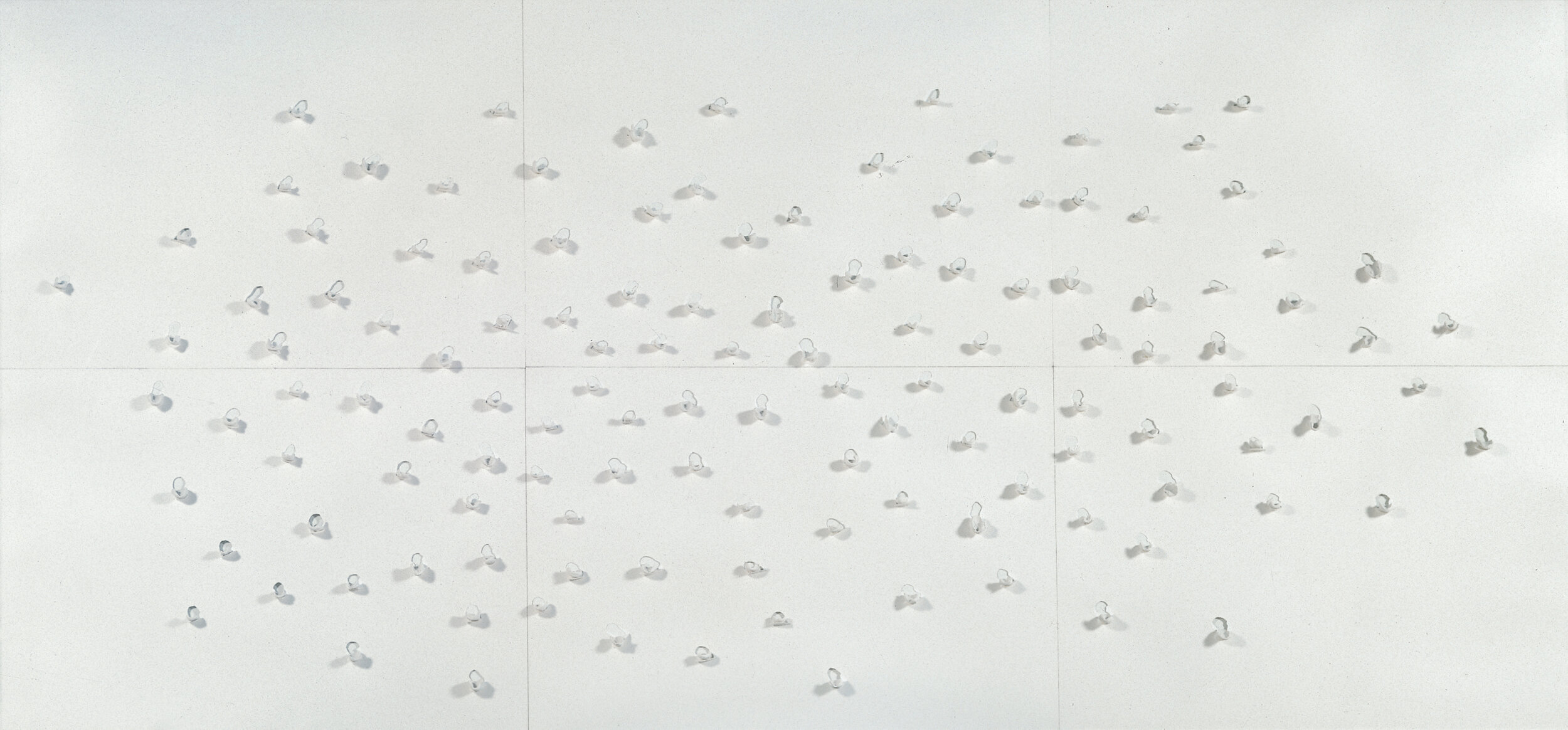






Curator’s selection from G I collection.
Peter Fischli, Swiss. Born in 1952. Lives and works in Zürich. David Weiss, Swiss. Born in 1946. Lives and works in Zürich.
Ohne Title (Pyramiden) Hostesses
1988/89
Colour photograph and sculpture in gypse.
Sculpture: 113 x 27 x 20 cm
Photography: 155 x 215 cm
Fischli & Weiss succeed in applying the sound Swiss qualities to the art world, staging totally chaotic situations into a regular as clockwork environment. Fischli and Weiss started their carreer in 1979 with a series of photographs called Wustserie, followed by the film der geringe Widerstand. They adore pulling the spectator’s leg, offering him situations in which he “doesn’t get what he sees”.
Material and object play hide-and-seek and the poor connoisseur forgets everything he knows. Fischli & Weiss confront you with the archetypes of image building leading you through the world of kitch.

Curator’s selection from G I collection.
American, born 1958, Pennsylvania - 1990, New York.
Untitled Tarp (May 4-1983, Napoli)
1983
Acrylic on plastic tarpaulin
290 x 290 cm
At the end of the eighties, Keith Haring fetched this strong images from the New York subculture. Nevertheless, he begins to draw abstract patterns and studies the work of Jean Dubuffet, Paul Klee, Jackson Pollock and Mark Tobey, but is it is Pierre Alechinsky’s paintings which will have a decisive influence on this artists carrier. In 1978 he travels to New York, living the gay-scene and learning graffiti techniques. He constitutes a catalogue of easy-to-draw pictograms and develops his own style. In 1983, he gets to know Andy Warhol and becomes part of the international art scene.

Curator’s selection from G I collection.
German, born 1932, Dresden. Lived and worked in Köln.
Abstraktes Bild 708-4
1989
Oil on canvas
72 x 102 cm
Studied at the Dresden Academy and moved in 1961 to the Western Germany, where he studied at the Dusseldorf Academy, together with Ferdinand Mackentanz. He works in an abstract-impressionist style. Later he meets Sigmar Polke, Konrad Fischer and others.
In 1962, he starts his photographic work, which are in fact black white paintings based on amateur and press photography. He investigates the interface between painting and photography in relation to the representation of reality.
Richter shows in this way the sheer basis of painting itself. In 1968 he makes the Townscapes series and the Alp series, examining the tension between the near and the distant. This is in 1971 followed by the Colour Fields and Grey Images, in which he looks for the different components of a painting.
Primary colours are inventoried in 1.024 RAL-colours. Those are followed by 48 Portraits and Proclamation after Titian.
In 1976 he paints this Abstract Images, divided into Candles, Skulls and Landscapes. The abstract painting becomes the real subject and motive of his work. Richter works simultaneously both these themes, abstraction and realism.

Curator’s selection from G I collection.
American, born 1937, North Ronawanda, New York.
Untitled
1985
Gouache and pencil on paper
164 x 164cm
In 1964 Mangold constitutes the basis for his unique work. In contrast to Robert Ryman, the pictorial process is not important for him.
In first instance, a painting is a pictorial surface not referring to the world outside. Border, pictorial surface and line are equal elements.
Mangold is part of a group American Minimal Artists who found new solutions to the formal problems of painting and sculpting.

Curator’s selection from G I collection.
Italian, born 1947, lives and works in Torino.
73 Unghiate
1990
Plaster and paper
140 x 300 cm
In 1968, together with a Nord-Italian group, Penone reacts against the American Pop-Art movement. The Arte Povera-group, as it is later named, uses non-traditional materials taken out of daily reality.
Fascinated by the growth process in nature, Penone will very quickly adopt primary material which he finds in nature. Growth tree rings illustrate this state of mind perfectly; man has to deal with nature in the same way as the slow growth process; nature is the ordered principle, not man.
The artist makes a work but cannot control its evolution. Nevertheless, man is the measuring principle of the artwork.
Penone investigates the fringe area between the body and the outer world (breath, home, brows, eyes, nails, the imprint of the body in the surrounding material as a heap of treeless…).
